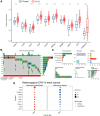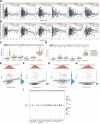A cuproptosis-related gene signature and associated regulatory axis in stomach adenocarcinoma based on bioinformatics analysis
- PMID: 37505170
- PMCID: PMC10378823
- DOI: 10.1097/MD.0000000000034230
A cuproptosis-related gene signature and associated regulatory axis in stomach adenocarcinoma based on bioinformatics analysis
Abstract
Stomach adenocarcinoma (STAD) is a highly aggressive and extremely heterogeneous gastric cancer characterized by high morbidity and mortality. Cuproptosis, a copper (Cu)-triggered modality of mitochondrial cell death, could regulate tumor proliferation and metastasis. Least absolute shrinkage and selection operator cox regression analysis was constructed to develop a prognostic cuproptosis-related signature. A lncRNA-miRNA-mRNA regulatory axis was performed to explore cuproptosis-related mechanism for STAD. The expression of FDX1, LIPT1, DLD, DLAT, PDHA1, PDHB, MTF1, GLS, and CDKN2A was upregulated in STAD versus normal tissue. We also summarized single nucleotide variants and copy number variation landscape of cuproptosis-related gene in STAD. Further analysis demonstrated that STAD patients with high expression of CDKN2A, DLD, GLS, and MTF1 and low expression of DLAT, FDX1, PDHA1 and PDHB had a poor overall survival (OS) and post progression survival (PPS) rate. By performing least absolute shrinkage and selection operator cox regression analysis, we constructed a cuproptosis-related prognostic signature for STAD. Further analysis demonstrated a significant correlation between FDX1 expression and immune cell infiltration, tumor mutational burden (TMB) score, microsatellite instability (MSI) score and drug sensitivity. Univariate and multivariate analysis indicated FDX1 expression and clinical stage as independent factors affecting the prognosis of STAD patients. We also identified a lncRNA MALAT1/miR-328-3p/FDX1 regulatory axis for STAD. Multi-omics approaches were performed to develop a cuproptosis-related signature with 2 genes (FDX1 and MTF1) for STAD. We also identified a lncRNA MALAT1/miR-328-3p/FDX1 regulatory axis for STAD.
Copyright © 2023 the Author(s). Published by Wolters Kluwer Health, Inc.
Conflict of interest statement
The authors have no conflicts of interest to disclose.
Figures







References
-
- Sung H, Ferlay J, Siegel RL, et al. . Global cancer statistics 2020: GLOBOCAN estimates of incidence and mortality worldwide for 36 cancers in 185 countries. CA Cancer J Clin. 2021;71:209–49. - PubMed
MeSH terms
Substances
LinkOut - more resources
Full Text Sources
Medical
Miscellaneous

